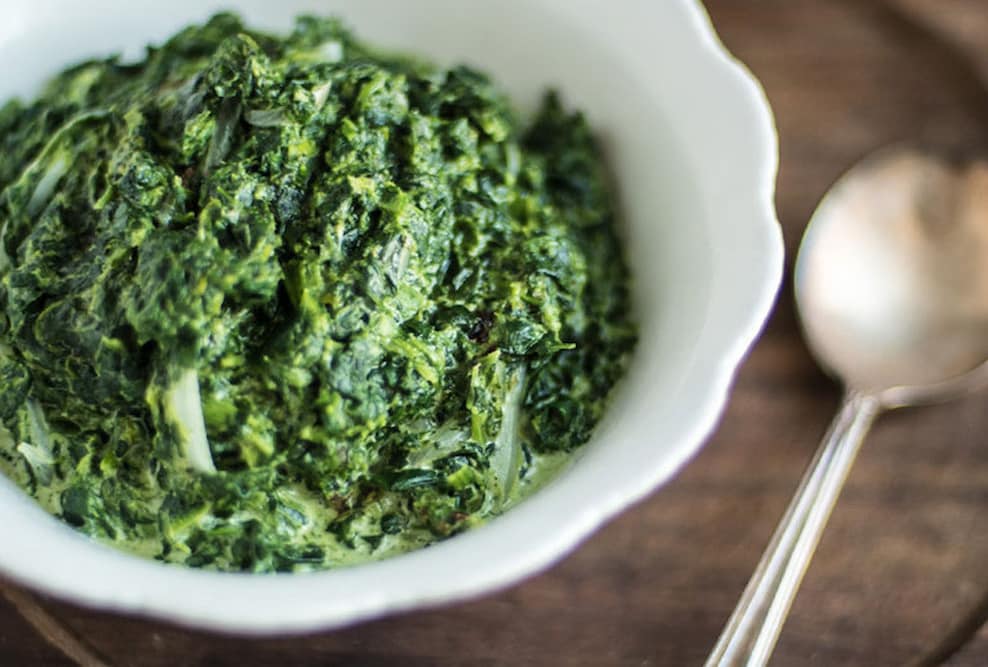Vegetarians know that canned spinach with no salt added is healthy for their bodies. The typical length of a single leaf from the annual plant Spinacia oleracea, often known as spinach, is between 2 and 30 centimeters.
Spinacia oleracea is the scientific name for spinach. No one knows for sure which of the two most common types of spinach Popeye preferred, but we’re betting on the smoother flat leaf kind since it’s easier to get canned or frozen. You may get curly leaf spinach, which is also known as savoy spinach, in pre-washed containers at the supermarket or salad bars.
The leaves of this kind of spinach are wrinkled. When gathered at such a young age, this kind of spinach is known as “baby spinach.” In addition, a hybrid between the curly leaf variety and the flat leaf sort is known as semi-savoy.
The debate about how much iron may be found in these dark leafy greens centers on a study written by a dietician and published in a scientific journal. After being presented as truth for almost 30 years in medical publications, textbooks, and popular culture, criminologist Mike Sutton finally refuted the misconception that spinach did not contain any more iron than other common vegetables in a painstakingly studied paper.
The article debunked the theory. Sutton reasoned that the German scientists couldn’t possibly exist since they were impossible to find.

It’s common knowledge that beef liver contains a lot of iron, but one cup of cooked fresh spinach has roughly a milligram more iron than that. Quite a little more than you’d find in a single lettuce leaf. To receive as much iron as you would from a serving of spinach, you would have to eat a whole head of lettuce.
Lettuce’s meager 2.02 milligrams of iron are among the lowest of any vegetables. Spinach, on the other hand, has oxalic acid, which blocks iron absorption. Consuming it alongside foods that aid in the absorption of iron, such as meat, fish, poultry, citrus fruits, and certain vegetables (broccoli, sweet peppers, tomatoes, and potatoes), is thus recommended.
Spinach has an unprecedentedly high nutritional density. It is a good source of iron and numerous other vitamins and minerals, including B and C, and the antioxidants beta-carotene and lutein, which the body converts into vitamin A.
Spinach also provides a good amount of other important elements like magnesium and zinc. There aren’t a lot of ways to find the best canned or frozen spinach at your local grocery shop until you find the one that works best for you.
First, make sure you know when it will go bad, then compare pricing. However, fresh spinach requires a little more care while being prepared. If you want to enjoy your spinach at its brightest, look for firm, upright leaves with a deep viridian tint.

The color is reminiscent of tropical rainforests and towering trees. After that, you should inspect the undersides of a few leaves for signs of damage, such as bruises, abrasions, or yellowing.
If you don’t purchase pre-washed spinach, you’ll need to rapidly wash the leaves by immersing them in a basin of cold water, swishing them around, and then draining the bowl to remove any sand or other debris that may have gathered on the leaves. After you have done this a few times, the spinach should be clean enough to eat. You shouldn’t buy more fresh spinach than you will eat within a few days since the nutrient value declines with time.
It’s important to note if a recipe calls for fresh, tinned, or frozen spinach when preparing dishes using this vegetable. The three different approaches to food preparation each have their benefits and drawbacks.
To get the same output as you would with canned spinach, you would need to use a significantly larger amount of fresh spinach due to its high-water content (92%). One thing about spinach, however, is indisputable: if you choose to eat it, it will improve your health. To maintain good health, adults should consume 8 milligrams of iron per day.
Women who are menstruating need 27 milligrams, whereas those who are expecting need just 18. The health benefits of spinach may be obtained, but only via regular consumption. Here are seven very good reasons why you should. To most people, when they are urged to “add some greens to the recipe,” the first vegetable that comes to mind is spinach.
We’ve all seen cartoons where the hero gets a power boost from eating spinach, and we’ve all listened to our parents and grandparents gushing about the health benefits of this leafy green. However, the link between spinach and toughness is not without foundation.

Did you know that eating only one serving of spinach per day (around 100 grams) adds just 23 calories to your diet? When compared to the health benefits it may bring, the price is quite low. Spinach is a complete protein, boasting all of the essential amino acids, as well as vitamins A, C, and K1, folic acid, calcium, and iron.
A green leafy vegetable, like spinach. The majority (91%) of its composition is water, which may come as a shock to some. Therefore, your body’s water balance is preserved. All of these nutrients can enhance your health and well-being in general. Consuming it on an infrequent basis is probably safe.
It is recommended that this superfood be consumed regularly to get the full benefits. Think it’s out of the question to accomplish? If that’s the case, we’d want to bribe you, if that’s OK. The following are just a few of the many potential advantages of adding spinach to your regular diet: 1. Consuming spinach may aid in weight loss because of its low-calorie content.
In addition to its high-water content, it also contains a high concentration of fiber, which aids in digestion and nutrient absorption.
Because of this, your metabolism won’t fluctuate and you’ll keep losing weight. In addition to helping keep blood sugar levels stable, spinach may also help lower bad cholesterol. This is another reason why your body won’t have to fret about its size.
2. Your blood flow will improve significantly. Keeping blood viscosity in check, spinach’s high-water content facilitates blood flow. It is well known that hemoglobin levels in the blood must be maintained at healthy levels, and this requires a steady supply of iron. When under control, your blood oxygen levels will improve.

Furthermore, iron contributes to the production of new RBCs throughout the process of blood cell renewal. Nitrates, which are abundant in spinach, are also known to control blood pressure levels throughout the body.
This ensures that your heart always has enough blood to pump and circulate properly. 3. You’ll have beautiful skin.
The protein collagen is something you may or may not have heard of. Simply explained, it’s a kind of protein responsible for the structural integrity of your skin. The presence of collagen aids in the maintenance of its shape, color, and pliability.
We’re telling you this because research has shown that eating spinach may boost your body’s natural supply. Due to this, you’ll see a dramatic improvement in your skin’s health once you start eating it regularly.
4. As a result, you’ll feel less stressed. Spaghetti with spinach may help your brain as well as your body. Spinach’s anti-anxiety and anti-depressant properties may aid you in maintaining your composure under pressure.
Spinach also contains other components that can prevent the course of cognitive impairment, including folates, lutein, and vitamin A. One of the healthiest foods available, spinach is a superfood.
5. As you age, your bones become stronger. After the age of 35, women seem to have an increased incidence of orthopedic issues. When left untreated, osteoporosis, which causes bones to become fragile and break more easily, might develop.
However, because of its high vitamin K and calcium content, spinach may aid in the process of building stronger bones. Vitamin K is a crucial ingredient for bone health because it promotes bone repair and regeneration.
6. Any damage you sustain will heal more quickly. Spinach’s nutritional content helps the body recover from fatigue and injury.
Include spinach in your daily diet. The vitamin C in it is well-known for its capacity to boost the immune system, and the many antioxidants and flavonoids it contains will help you stay healthy and happy in general.

7. With time, you’ll notice an improvement in your eyesight. Too much time spent staring at displays like those on computers and smartphones may cause tiredness in the eye muscles. If you eat spinach often, however, you won’t have to worry about it happening. The eye-healthy minerals lutein and zeaxanthin may be found in plentiful supply in spinach.
The risk of developing age-related macular degeneration is lowered by both of these nutrients. Sun exposure has additional risks, including possible retinal damage.
However, if you include spinach in your diet daily, you may be able to greatly decrease the probability of that occurring. Isn’t it a stunning presentation of spinach? Don’t forget to get a bunch of fresh spinach the next time you’re at the supermarket.

Your comment submitted.